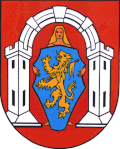| Parish Church of Saints Philip and James | |
|---|---|
| Župna crkva svetih Filipa i Jakova | |
 | |
 Parish Church of Saints Philip and James | |
| 45°20′50″N19°00′26″E / 45.34722°N 19.00722°E | |
| Location | Vukovar |
| Country | Croatia |
| Denomination | Roman Catholic |
| Website | filipjakov-vu |
| History | |
| Status | Parish church |
| Dedication | Saint Philip and Saint James |
| Dedicated | 1738 |
| Architecture | |
| Functional status | Active |
| Style | Baroque |
| Groundbreaking | 1723 |
| Completed | 1732 |
| Specifications | |
| Length | 60 m (197 ft) |
| Floor area | 700 m2 (7,535 sq ft) |
| Number of spires | 1 |
| Bells | 3 |
| Administration | |
| Metropolis | Metropolis of Đakovo-Osijek |
| Archdiocese | Archdiocese of Đakovo-Osijek |
| Deanery | Vukovar Deanery |
| Parish | Parish of Saints Philip and James - Vukovar |
The Church of Saints Philip and James (Croatian : Crkva svetih Filipa i Jakova) is a Roman Catholic church in Vukovar, Croatia.

